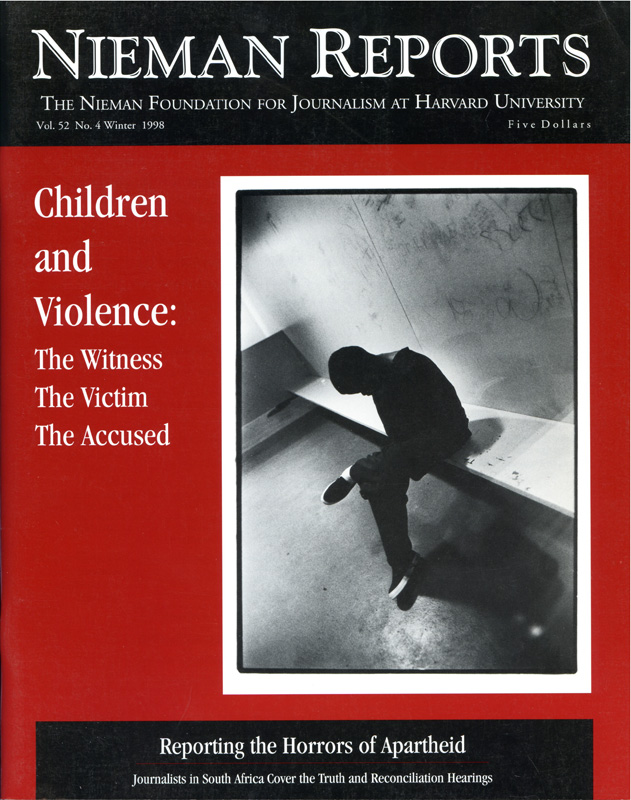There are some important lessons we’ve learned about how the coverage of violence—especially juvenile violence—influences the way many of us think about teenagers and crime.
Related Article
- We’ve learned that coverage of crime stories on television news has gone up dramatically while actual crime has remained relatively constant, or even gone down during the same time periods.
- We’ve learned that during the 1990’s, crime has become the number one story covered by network nightly news. In 1993,1994, 1995 and 1997, crime stories ranked first among network stories. In local markets, crime stories consume one-quarter to one-third of total news time.
- We’ve learned from surveys that the public believes crime is rampant, except in their own neighborhoods and communities, primarily because of the way the media present this “news.”
- We’ve learned that media portrayals of youth violence, especially visual images, are dominated by pictures of African-Americans or Latino youngsters.
- We’ve learned from one large-scale analysis of local TV that more than two-thirds of coverage of violent crime was focused on juveniles while youth were actually responsible for less than 15 percent of the violence.
- We’ve learned that when the media focus on youth violence and juvenile delinquency, they report disproportionately on homicide, which is the least common antisocial behavior of teenagers.
- We’ve learned, from one analysis, that 40 percent of stories newspapers do about children are related to violence (compared with 25 percent that are related to education).
In “false images? The News Media and Juvenile Crime,” a report we issued last year, we examined in-depth the question of whether the news media “accurately portrayed the reality of juvenile crime.” With some notable exceptions, our findings suggest that “while juvenile delinquency and violence are often treated as epidemic by the news media, this is not supported by the facts.…this media firestorm has either created or reinforced a public impression that juvenile crime is rampant and a major threat to the safety of the community….(and) slight increases in juvenile crime have been blown out of proportion….while reductions in juvenile violence have frequently gone unreported.”
Alfred Blumstein, a criminologist at Carnegie Mellon University, summed up our findings with the following observation: “Most of us have the sense that crime has been moving up incessantly. That’s because a crime-increase story is a page one story, and a crime-decrease story is a page 23 story.”
The impact of inaccurate reporting or inappropriate placement of stories is that public perception and, consequently, political reaction often becomes misguided. As our report concluded, “The media have contributed to and fueled the superficiality of the discourse and the hysterical tone of the political debate.”
Part of the sensationalizing that our report highlights is illustrated by a few examples of headlines from the covers of national newsmagazines when they have devoted coverage to these topics. “Teen Violence: Wild in the Streets,” Newsweek declared on its August 2, 1992 cover. A year later, U.S. News & World Report chose for its cover line the following: “Guns in the Schools: When Killers Come to Class—Even Suburban Parents Now Fear the Rising Tide of Violence,” and in 1996, this same magazine revisited this topic with a cover story entitled “Teenage Time Bombs.” Time visited this issue, too, in a cover story calling these violent youngsters “Children Without Pity.”
Certainly not all media coverage of juvenile crime has been either misleading or blown out of proportion when compared with the real and difficult challenges it presents to families, communities and public officials. And it is important to understand the common threads that connect the kind of reporting that helps readers and viewers to understand the threat posed by teenage violence, the reasons why it is occurring, and what might be done to prevent it from happening in the future.
Our report spotlights what we call “good media practices” that have emerged out of media outlets’ deliberate efforts to establish policies and develop new approaches to coverage of crime and delinquency. Several common factors emerge, regardless of whether the medium is print or broadcast.
- Traditional episodic coverage of homicides and other violent crimes is replaced by beginning reporting with a basic question: “What is news in the coverage of crime?” At one local TV station, KVUE-TV in Austin, Texas, since January 1996, a crime story has had to meet one or more of five criteria for details of it to be reported.
- Does action need to be taken?
- Is there an immediate threat to safety?
- Is there a threat to children?
- Does the crime have significant community impact?
- Does the story lend itself to crime-prevention efforts?
- Violent crimes are not reported prominently without accompanying in-depth analysis, setting it in a broader human and policy context. When reporting a homicide or violent crime, for example, certain questions will be addressed in the story.
- Did the victim and perpetrator know each other or were they related?
- Was there a history of domestic violence related to this crime?
- Was alcohol or other substances involved?
- If a shooting involves a young person, can the gun used be traced back to its point of origin and intermediate transfers?
In other words, our report noted, “The violence story is dealt with in the context of more of a public health orientation and perspective.”
We’ve learned a lot about what doesn’t work well in reporting crime. But along the way we’ve also found some splendid examples of how much better coverage can be when facts and context about juvenile crime and violence—no matter how their presence might dampen sensational aspects of these stories—are given the kind of attention we believe they merit.
David Doi is Executive Director of the Coalition for Juvenile Justice, the national coalition for State Juvenile Justice Advisory Groups.
Information for this article came from the Coalition for Juvenile Justice’s November 1997 report “false images?” Copies are available by calling 202-467-0864.



